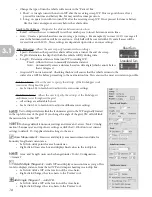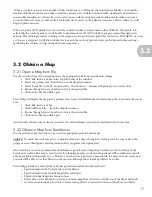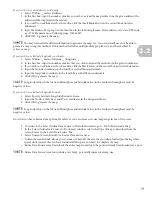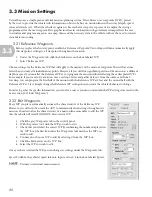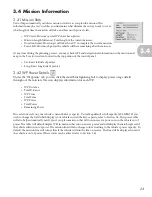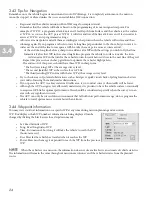
10
2.1 Safety
The EcoMapper AUV is a scientific instrument and should be treated with caution. The vehicle should only be operated
by qualified personnel. Misuse or tampering with the AUV can result in serious personal injury or permanent vehicle
damage. Listed below are a compilation of the warnings found in this manual. While reading the manual, the warnings
will also reappear in their appropriate sections designated with the caution symbol. This warning directory is not a
comprehensive list of the potential hazards associated with this instrument. The directory is simply a guide to
encourage proper and safe use of the vehicle.
Take Caution when you see this symbol. Harm to yourself or your equipment may occur.
• Never insert fingers in the Kort nozzle area when the vehicle is powered on.
• Never run the motor for extended periods of time when the vehicle is out of the water.
• Use caution when applying silicone lubricant to O-rings. Lubricant can irritate skin and eyes. Always wash
hands thoroughly following contact.
• Never access the interior of the AUV without training from a qualified YSI employee.
• Never clean or wipe O-rings with anything other than laboratory/scientific wipes. Normal tissues and cloths
can leave residue that could compromise the seal’s integrity.
• Always check that the map is geo-referenced correctly by running a small mission close enough to recover
the vehicle via manual WiFi connection in the event that the map has faulty coordinates.
• Always perform a pre-launch check-off of control fins and propeller before deploying the vehicle.
• Always ensure that the vehicle has the proper weight and balance in the water before releasing the vehicle at
deployment. Failure to do so may sink the vehicle due to lack of buoyancy.
• Always be sure to allow enough room for the AUV to miss obstacles when in motion. The vehicle will not
automatically sense obstructions in its path.
• Always plug the charging cord into the two-pin charging connector on the vehicle BEFORE plugging the
charger into the wall. This will prevent arcing that could harm the connection.
• Always fully service O-rings whenever the antennae or tail section is removed.
• Always ensure that the vehicle’s control planes are clear of potential hazards during deployment to avoid
breaking them.
• Always bring the batteries to below 40% capacity before commercial transport due to shipping regulations.
• Always ensure that the safety rule time out is longer than the estimated mission time.
• Before handling any chemicals, be sure to read and follow all safety instruction and MSDS documentation
provided with the chemical. Only trained personnel should handle chemicals.
• Although not required, it may be prudent to contact local authorities and governing agencies when you
deploy the AUV. This notification can make the survey process much smoother and encourage good
relationships between the user and community.
2.1
!
!

















